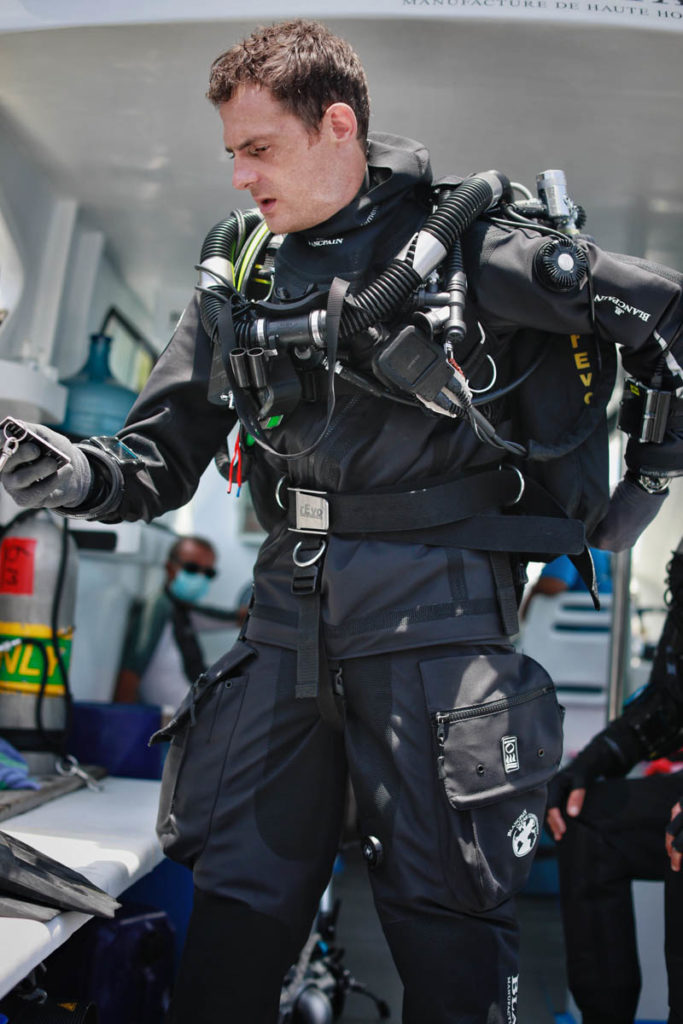Drysuits in the tropics, from a ludicrous idea to serious debate where the state of things currently sees more and more people diving dry in warm tropical water but why?
Most of us know the advantages of diving in a Dry Suit for cold waters, but do the same benefits stack up when diving in Tropical Waters? The short answer is an emphatic YES! In fact, my position is that the advantages of diving dry are independent of the climate and in this article, I will aim to explain how those benefits will apply broadly to your diving, and if you are a technical diver, is almost a must to have
Having originally learned to dive and being the envy of my classmates during the final stages of training in a drysuit I have always seen the benefit of using this type of specialized exposure suit. While working in the Red Sea I opted to dive dry during the winter months and was one of the first instructors/guides that did so. Drysuits are now common in the Red Sea especially in the winter months when the surface conditions are cold and can be very wind chilled.

Now living in Bali where we have average air temperatures in the 30’s and year-round average water temperature in the high 20’s (normal sport diving depths) with humidity running at around 70% why use a drysuit here? Well firstly what we need to look at is what advantages do drysuits bring us specifically in this environment, as well as dispel some myths.
Thermal Considerations:
Let’s go back to our original SCUBA class and remind ourselves of some basic physics, water conducts heat 25 times faster than air therefore even when water temperatures are near equal to the air temperature, the extended duration of exposure dramatically increases thermal stress, personal discomfort, and increased susceptibility to DCS.
Firstly, what we need to clarify is what does a drysuit do? It keeps you DRY; it does not keep you warm otherwise we would call it a warm suit! The advantage of being dry is that we therefore are not in contact with water. If we are not in contact with water the conductive properties of water do not effect us as much. I obviously spend a considerable amount of time in water both diving and teaching, therefore my exposure to the water are lengthy where both core temperature cooling is a real concern increasing susceptibility to DCS, even when the water is apparently warm an exposure of 3-5 hours will reduce thermal comfort considerably. Using a drysuit on longer duration dives especially more technically oriented dives increases comfort and therefore safety. Wetsuits do not warm us; they try to retain and minimize heat loss, but this is just not possible on longer dives.
Thermal regulation can be adapted more easily in a drysuit and with the modern suits and under garments you can just add or remove layers as needed to increase the level of insulation. The drysuit keeps you dry, the undergarments are selected and adjusted to keep you warm. For the majority of my dives in tropical water I am fine with a simple base layer, where I prefer the J2’s from Fourth Element, but when the mission requires something more, I then just add additional layers to insure correct insulation and minimal thermal stress.
Post dive cooling is considerably reduced which again is a big advantage in reducing susceptibility to DCS, and your comfort and enjoyment is definitely higher after a dive when you strip out of your suit without shivering. Plus, getting back into a suit after a surface interval is no longer having to force your body parts into a damp cold possibly smelly wetsuit!
Buoyancy and Redundancy:
Drysuits offer additional redundant buoyancy which is desirable when you are in water with large amounts of equipment and therefore additional weight. One of the main mantras of technical diving is that all life support gear needs to be redundant. If you are engaging in any form of technical diving, you are most likely carrying approximately your own body weight in gear. If you are now also adding weight to counteract the buoyancy of using a neoprene wetsuit in shallow
water will lead to being overweighted. Using only one source of buoyant lift therefore is placing all your eggs in one basket. Adding a redundant wing to this could increase drag, therefore workload, CO2 retention and a higher gas consumption will further increase risk as well. You can reduce your overall profile and therefore surface area whilst still carrying a redundant buoyancy device by just opting to use a drysuit. In addition to this, around Bali and throughout the Indonesian archipelago the ocean currents can be extremely strong and unpredictable therefore floating in water in a drysuit is safer in the unlikely event of an extended surface drift.
Drysuits promote good trim and body positioning whilst enhancing buoyancy, and with some particular configurations there is no way to balance it correctly without the aid of a drysuit. Buoyancy changes are constant with the trilaminate style of drysuits, therefore weighting is easier and can be set to optimum. With thicker wetsuits the suit can be buoyant in the shallows due to the material not having been compressed, but at depth this buoyancy disappears because of the issue of compression, and we find ourselves more negative.
Drysuits are more robust than their wetsuit counterparts, something that is an issue for me is regardless of brand I am unable to get more than 12 months from a standard 5mm wetsuit. After that time the material has been reduced to the equivalent of a slice of Swiss cheese. The neoprene used in the modern dive suits has had to compromise on strength to provide flexibility, suppleness, and style, all of which negatively impact its longevity. Wetsuits cannot withstand the repeated compression and decompression that is diving to depth on a daily basis.
Diving dry became a necessity here due to a continuing research project we are currently involved with. Diving to 100m+ on consecutive days in the waters around Bali where upwelling is a concern and water temperatures can drop to 16 degrees C. Wetsuits with multiple layers were no longer an option and could not withstand the duration and consistent nature of the dive schedule. Having been a fan of the stronger more robust crushed neoprene drysuits I was somewhat apprehensive about moving over to trilaminate, but this turn out to be a pleasant and positive surprise. Trilaminate style suits are now also designed with warmer surface environments in mind and therefore are robust but super lightweight and some are even breathable therefore reducing the risk of sweating whilst getting dressed and ready, which later in the water would then cause unnecessary cooling.
Another thing that has concerned me with drysuits is the seals and this is the biggest issue in an area where drysuits are not traditionally used, getting them repaired is nearly impossible. I learnt early on that latex seals in warm climates was a receipe for disaster and employed neoprene seals for numerous years. The trade in with neoprene seals is that they are not normally as watertight as latex, but this was a small price to pay in warm waters. The introduction of the ring systems for both neck and wrists in combination with the silicone seals is a massive move forward for drysuit technology and allows for a quick, easy, and clean seal replacement within minutes even whilst at the dive site.
In short, if you dive tech, like long duration dives with your camera or simply are a WIMP (Warm Intelligent Marine Person) that gets cold quickly whilst diving, then a dry suit is something serious to consider.

What to watch out for:
Training:
Drysuits do add another certain amount of complexity to your dealing with equipment configuration and buoyancy control and therefore it is something that you need to be shown how to use correctly under the guidance of an experienced instructor. What needs to be involved in proper training is actual in water time using your drysuit and going through skills and scenarios for the gear configuration that you are planning on using. Normally this should be between 2-4 dives spread over 2-3 days depending on the level.
Another important part of training is understanding the care and maintenance aspects of your chosen drysuit, and what you configured it with. Manufacturers have made suits much sturdier and more robust and use the latest developments in materials and fabrics to reduce the
amount of time you the diver need to care for your drysuit. However, there are still some critical basics that need to be covered in training, so you get the most out of your investment.
TOP 5 DRYSUIT SELECTION TIPS
- Trilaminate over Neoprene: Trilam suits are now my preferred type due to their obvious advantages in tropical conditions. These suits keep you dry, are easy to field fix and are more lightweight and travel friendly compared to neoprene. Additionally, trilaminate suits now are breathable so you don’t turn into a boil in the bag meal as you would in a neoprene suit.
- Silicone wrist/neck seals are the only way to go in the tropics trust me, and you can replace a seal on a boat or beach without having to cancel the day of diving.
- Pee valves have obvious advantages, when diving we all know the importance of hydration and although we can get away with having an accident in a wetsuit, a drysuit is a different story. Having the option to relieve yourself quickly and easily is a primary safety advantage on longer dives. Adult diapers are another option, but then the dive is going to be either very long or maybe avoid spicy food before the dive
- Turbo soles/socks not boots, just like undergarments I can select boots to go over the socks depending on the conditions I dive in. It is easier to just replace the boots that you pull on over the suit then removing and replacing boots that are integrated into the drysuit.
- Made to Measure whenever possible (it costs a bit more but makes so much difference.)
I hope that some go the things highlighted here have helped give a better overview of the advantages of diving dry even in the tropics.
The comfort and therefore safety from decreasing thermal exposure and core body heat loss, dramatically increases overall enjoyment as well as awareness, whilst reducing the risk of DCS. Managing and maintaining optimum body temperature is inherently difficult in a wetsuit especially over prolonged exposure and long duration that is part and parcel of technical diving or diver training. Post dive undressing and re-donning is more of a pleasure and less of a pain, and instead of ducking for the nearest hot shower (increased risk for post dive DCS) you can simply sit back and enjoy the view.
The additional redundancy of both lift and proper trim and positioning further highlight dry suit diving advantages.
Drysuits although they cost more are normally more hard wearing and last longer than wetsuits.
Proper guidance and training in the use of dry suits is mandatory and you need to get as much advice and feedback from an experienced dive professional that is doing the type of diving you are looking at doing.
Until next time stay safe and stay dry…;)






